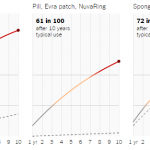First Things has started a new online feature I enjoy called “Family Facts.” The series is described as “an occasional series of data presentations about family and religious practice and analysis of their role in maintaining civil society.” Given how much I love data and data visualization, I’m delighted.
I’m not so delighted with the most recent installment on who children live with. Here’s the chart:
See that note on the side, where it says “Figures for 1961 to 1967 have been interpolated’? Interpolation is what you do when you are missing data. There are a lot of different procedures, but the most common, and the one I suspect they’re using here, is plotting the points you do have (1960 and 1968) and just connecting them with a line. This gives the impression that any change between these two points was steady, when, in fact, the data may have bounced around a bit.
It’s a little sloppy and, in this example, it’s entirely unnecessary. Here’s an easy fix: start the chart in 1968, the point when you start having year by year data. I assume they wanted to tack on the 1960 data to give the impression of stability prior to the countercultural movements, but they could still make that case with a better graph. Technically, moving up the date might make some readers a little suspicious about why they put the cut point there, but they could add a footnote that year by year data was only available starting in 1968.
And frankly, I’m suspicious about the cut point now. Where did that solitary 1960 datapoint come from? If data used to be collected every ten years (my guess) why not throw on a few more decades with interpolated data?
These are all presentational critiques, though some of the commenters at First Things have some good methodological questions like: how do you count joint custody? Cohabiting couples fall under ‘both parents’ right?
If you like this kind of thought, I recommend you follow Flowing Data, my favorite data visualization blog.












